A Remote Sensing and GIS Analysis of Rockfall Distributions from the 5 July 2019 Ridgecrest (MW7.1) and 24 June 2020 Owens Lake (MW5.8) Earthquakes
Abstract
1. Introduction
1.1. Study Area
1.2. Historic Rockfall Events in the Sierra Nevada
1.3. Ridgecrest and Owens Lake Earthquakes
2. Materials and Methods
3. Results
3.1. Rockfall Distribution from the MW7.1 Ridgecrest Earthquake
3.2. Rockfall Distribution from the MW5.8 Owens Lake Earthquake
3.3. Ridgecrest Event Slope Failure Distribution
3.4. Owens Lake Event Slope Failure Distribution
4. Discussion
5. Conclusions
- While both epicenters were in valley bottoms ~20–25 km from the north-south trending main Sierran crest, the smaller Owens Lake event produced approximately two-times as many recognizable rockfalls greater than 1000 m2 in size than the stronger Ridgecrest event.
- The anomaly in intensity between the two earthquakes and the resultant rockfall totals suggests that the glacially oversteepened slopes of the HS may have a lower threshold for failure.
- While both areas experienced some degree of seismic amplification, in the southern LS area, these effects were far more pronounced likely due to the significantly higher displacements from the Ridgecrest event and the orientation of ridgelines.
- In both areas, amplification of ground motion by local topography likely generated self-triggering processes that reactivated existing rockfall source areas.
Author Contributions
Funding
Data Availability Statement
Acknowledgments
Conflicts of Interest
References
- Lacasse, S.; Eidsvik, U.; Nadim, F.; Hoeg, K.; Blikra, L.H. Event Tree Analysis of Aknes Rock Slide Hazard. In Proceedings of the 4th Canadian Conference on Geohazards, Quebec City, QC, Canada, 20–24 May 2008; pp. 20–24. [Google Scholar]
- Sättele, M.; Krautblatter, M.; Bründl, M.; Straub, D. Forecasting rock slope failure: How reliable and effective are warning systems? Landslides 2016, 13, 737–750. [Google Scholar] [CrossRef]
- Keefer, D.K. The importance of earthquake-induced landslides to long-term slope erosion and slope-failure hazards in seismically active regions. In Geomorphology and Natural Hazards; Elsevier: Amsterdam, The Netherlands, 1 January 1994; pp. 265–284. [Google Scholar] [CrossRef]
- Stock, G.M.; Uhrhammer, R.A. Catastrophic rock avalanche 3600 years BP from El Capitan, Yosemite Valley, California. Earth Surf. Process. Landforms 2010, 35, 941–951. [Google Scholar] [CrossRef]
- Cruden, D.M.; Varnes, D.J. Landslide types and processes. In Landslides: Investigation and Mitigation; Turner, A.K., Schuster, R.L., Eds.; Special Report; Transportation Research Board: Washington, DC, USA, 1996; Volume 247, pp. 36–75. [Google Scholar]
- Hungr, O.; Leroueil, S.; Picarelli, L. The Varnes classification of landslide types, an update. Landslides 2014, 11, 167–194. [Google Scholar] [CrossRef]
- Corominas, J.; Mavrouli, O.; Ruiz-Carulla, R. Magnitude and frequency relations: Are there geological constraints to the rockfall size? Landslides 2018, 15, 829–845. [Google Scholar] [CrossRef]
- Matthes, F. Geologic history of the Yosemite Valley. U.S. Geol. Surv. Prof. Pap. 1930, 160, 137. [Google Scholar]
- Adams, J. Contemporary Uplift and Erosion of the Southern Alps, New Zealand. GSA Bull. 1980, 91, 1–114. [Google Scholar] [CrossRef]
- Pearce, A.J.; Watson, A.J. Effects of earthquake-induced landslides on sediment budget and transport over a 50-yr period. Geology 1986, 14, 52–55. [Google Scholar] [CrossRef]
- Wieczorek, G.F.; Snyder, J.B.; Alger, C.S.; Isaacson, K.A. Rock Falls in Yosemite Valley, California; US Geological Survey: Menlo Park, CA, USA, 31 December 1992; pp. 92–387. [Google Scholar]
- Hovius, N.; Meunier, P.; Lin, C.-W.; Chen, H.; Chen, Y.-G.; Dadson, S.; Horng, M.-J.; Lines, M. Prolonged seismically induced erosion and the mass balance of a large earthquake. Earth Planet. Sci. Lett. 2011, 304, 347–355. [Google Scholar] [CrossRef]
- Li, G.; West, A.J.; Densmore, A.L.; Jin, Z.; Parker, R.N.; Hilton, R.G. Seismic mountain building: Landslides associated with the 2008 Wenchuan earthquake in the context of a generalized model for earthquake volume balance. Geochem. Geophys. Geosystems 2014, 15, 833–844. [Google Scholar] [CrossRef]
- Marc, O.; Hovius, N.; Meunier, P.; Gorum, T.; Uchida, T. A seismologically consistent expression for the total area and volume of earthquake-triggered landsliding. J. Geophys. Res. Earth Surf. 2016, 121, 640–663. [Google Scholar] [CrossRef]
- Malamud, B.D.; Turcotte, D.L.; Guzzetti, F.; Reichenbach, P. Landslides, earthquakes, and erosion. Earth Planet. Sci. Lett. 2004, 229, 45–59. [Google Scholar] [CrossRef]
- Broeckx, J.; Rossi, M.; Lijnen, K.; Campforts, B.; Poesen, J.; Vanmaercke, M. Landslide mobilization rates: A global analysis and model. Earth-Sci. Rev. 2020, 201, 102972. [Google Scholar] [CrossRef]
- Sboras, S.; Lazos, I.; Mouzakiotis, E.; Karastathis, V.; Pavlides, S.; Chatzipetros, A. Fault modelling, seismic sequence evolution and stress transfer scenarios for the 20 July 2017 (MW 6.6) Kos–Gökova Gulf earthquake, SE Aegean. Acta Geophys. 2020, 68, 1245–1261. [Google Scholar] [CrossRef]
- Tong, P.; Yao, J.; Liu, Q.; Li, T.; Wang, K.; Liu, S.; Cheng, Y.; Wu, S. Crustal Rotation and Fluids: Factors for the 2019 Ridgecrest Earthquake Sequence? Geophys. Res. Lett. 2021, 48, e2020GL090853. [Google Scholar] [CrossRef]
- Yang, Z.; Zhao, D.; Cheng, B.; Dong, Y. Structural control on the 2019 Ridgecrest earthquake from local seismic tomography. Phys. Earth Planet. Inter. 2022, 324, 106853. [Google Scholar] [CrossRef]
- Nanjo, K.Z. Were changes in stress state responsible for the 2019 Ridgecrest, California, earthquakes? Nat. Commun. 2020, 11, 3082. [Google Scholar] [CrossRef]
- Stock, G.M.; Collins, B.D.; Santaniello, D.J.; Zimmer, V.L.; Wieczorek, G.F.; Snyder, J.B. Historical Rock Falls in Yosemite National Park, California (1857–2011); US Department of the Interior, US Geological Survey: Menlo Park, CA, USA, 2013; p. 17. Available online: https://pubs.usgs.gov/ds/746/ (accessed on 3 June 2022).
- Benjamin, J.; Rosser, N.; Brain, M. Emergent characteristics of rockfall inventories captured at a regional scale. Earth Surf. Process. Landforms 2020, 45, 2773–2787. [Google Scholar] [CrossRef]
- Worden, C.; Thompson, E.; Hearne, M.; Wald, D.B. ShakeMap Manual Online: Technical Manual., User’s Guide, and Software Guide, U.S. Geological Survey. 2020. Available online: http://usgs.github.io/shakemap/ (accessed on 3 June 2022).
- Bateman, P.C.; Wahrhaftig, C.; Bailey, E.H. Geology of the Sierra Nevada. In Geology of Northern California: California Division of Mines and Geology Bulletin; California Division of Mines & Geology: Sacramento, CA, USA, 1966; Volume 190, pp. 107–172. [Google Scholar]
- Bateman, P.C.; Eaton, J.P. Sierra Nevada Batholith: The batholith was generated within a synclinorium. Science 1967, 158, 1407–1417. [Google Scholar] [CrossRef]
- Le, K.; Lee, J.; Owen, L.A.; Finkel, R. Late Quaternary slip rates along the Sierra Nevada frontal fault zone, California: Slip partitioning across the western margin of the Eastern California Shear Zone-Basin and Range Province. GSA Bull. 2007, 119, 240–256. [Google Scholar] [CrossRef]
- Stevens, C.H.; Stone, P.; Blakely, R.J. Structural Evolution of the East Sierra Valley System (Owens Valley and Vicinity), California: A Geologic and Geophysical Synthesis. Geosciences 2013, 3, 176–215. [Google Scholar] [CrossRef]
- Moore, J.G.; Moring, B.C. Rangewide glaciation in the Sierra Nevada, California. Geosphere 2013, 9, 1804–1818. [Google Scholar] [CrossRef]
- Scuderi, L.A. Late-Holocene upper timberline variation in the southern Sierra Nevada. Nature 1987, 325, 242–244. [Google Scholar] [CrossRef]
- Scuderi, L.A.; Fawcett, P.J. Holocene environmental change resets lichen surface dates on Recess Peak glacial deposits in the Sierra Nevada, California. Quat. Res. 2013, 80, 180–188. [Google Scholar] [CrossRef]
- Beanland, S.; Clark, M.M. The Owens Valley Fault Zone, Eastern California, and Surface Faulting Associated with the 1872 Earthquake; US Geological Survey: Menlo Park, CA, USA, 1994. [Google Scholar] [CrossRef]
- Hough, S.E.; Hutton, K. Revisiting the 1872 Owens Valley, California, Earthquake. Bull. Seism. Soc. Am. 2008, 98, 931–949. [Google Scholar] [CrossRef]
- Muir, J. The Yosemite: New York; The Century Company: Lewistown, MT, USA, 1912. [Google Scholar]
- Wieczorek, G.F. Catastrophic rockfalls and rockslides in the Sierra Nevada, USA. CatastRophic Landslides: V. Effects, Occurrence and Mechanisms; Evans, S., DeGraff, J., Eds.; Reviews in Engineering Geology XV.; Geological Society of America: Boulder, CO, USA, 2002; pp. 165–190. [Google Scholar] [CrossRef]
- Wieczorek, G.F.; Jäger, S. Triggering mechanisms and depositional rates of postglacial slope-movement processes in the Yosemite Valley, California. Geomorphology 1996, 15, 17–31. [Google Scholar] [CrossRef]
- Wieczorek, G.F.; Morrissey, M.M.; Iovine, G.; Godt, J. Rock-Fall Potential in the Yosemite Valley, California; US Geological Survey Open-File Report; US Geological Survey: Menlo Park, CA, USA, 1999; Volume 99, p. 1. [Google Scholar]
- Wieczorek, G.F.; Snyder, J.B. Historical Rock Falls in Yosemite National Park, California; US Geological Survey Open-File Report; US Geological Survey: Menlo Park, CA, USA, 2004; Volume 3, p. 491. [Google Scholar]
- Given, J.W.; Wallace, T.C.; Kanamori, H. Teleseismic analysis of the 1980 Mammoth Lakes earthquake sequence. Bull. Seism. Soc. Am. 1982, 72, 1093–1109. [Google Scholar] [CrossRef]
- Harp, E.; Tanaka, K.; Sarmiento, J.; Keefer, D. Landslides from the 25–27 May 1980, Mammoth Lakes, California, Earthquake Sequence; US Geological Survey Miscellaneous Investigations Series Map I-1612; US Geological Survey: Menlo Park, CA, USA, 1984. [Google Scholar]
- Lee, J.; Spencer, J.; Owen, L. Holocene slip rates along the Owens Valley fault, California: Implications for the recent evolution of the Eastern California Shear Zone. Geology 2001, 29, 819–822. [Google Scholar] [CrossRef]
- Lee, J.; Stockli, D.; Schroeder, J.; Tincher, C.; Bradley, D.; Owen, L.; Gosse, J.; Finkel, R.; Garwood, J. Fault Slip Transfer in the Eastern California Shear Zone-Walker Lane Belt: Geological Society of America Penrose Conference Field Trip Guide; US Geological Survey: Menlo Park, CA, USA, 2006; 26p, (Kinematics and Geodynamics of Intraplate Dextral Shear in Eastern California and Western Nevada, Mammoth Lakes, California, 21–26 April 2005). [Google Scholar] [CrossRef]
- Cordes, S.E.; Stock, G.M.; Schwab, B.E.; Glazner, A.F. Supporting Evidence for a 9.6 1 ka Rock Fall Originating from Glacier Point in Yosemite Valley, California. Environ. Eng. Geosci. 2013, 19, 345–361. [Google Scholar] [CrossRef]
- Bacon, S.N.; Bullard, T.F.; Keen-Zebert, A.K.; Jayko, A.S.; Decker, D.L. Spatiotemporal patterns of distributed slip in southern Owens Valley indicated by deformation of late Pleistocene shorelines, eastern California. GSA Bull. 2020, 132, 1681–1703. [Google Scholar] [CrossRef]
- Bull, W.; King, J.; Kong, F.; Moutoux, T.; Phillips, W. Lichen dating of coseismic landslide hazards in alpine mountains. Geomorphol. Nat. Hazards 1994, 10, 253–264. [Google Scholar] [CrossRef]
- Dussauge-Peisser, C.; Helmstetter, A.; Grasso, J.-R.; Hantz, D.; Desvarreux, P.; Jeannin, M.; Giraud, A. Probabilistic approach to rock fall hazard assessment: Potential of historical data analysis. Nat. Hazards Earth Syst. Sci. 2002, 2, 15–26. [Google Scholar] [CrossRef]
- Guzzetti, F.; Malamud, B.D.; Turcotte, D.L.; Reichenbach, P. Power-law correlations of landslide areas in central Italy. Earth Planet. Sci. Lett. 2002, 195, 169–183. [Google Scholar] [CrossRef]
- Guzzetti, F.; Reichenbach, P.; Wieczorek, G.F. Rockfall hazard and risk assessment in the Yosemite Valley, California, USA. Nat. Hazards Earth Syst. Sci. 2003, 3, 491–503. [Google Scholar] [CrossRef]
- Picarelli, L.; Oboni, F.; Evans, S.; Mostyn, G.; Fell, R. Hazard characterization and quantification. In Landslide Risk Management; Hungr, O., Fell, R., Couture, R., Eberthardt, E., Eds.; Taylor and Francis: London, UK, 2005; pp. 37–61. [Google Scholar] [CrossRef]
- Tanyaş, H.; Allstadt, K.E.; van Westen, C.J. An updated method for estimating landslide-event magnitude. Earth Surf. Process. Landforms 2018, 43, 1836–1847. [Google Scholar] [CrossRef]
- Nowicki, M.A.; Wald, D.J.; Hamburger, M.W.; Hearne, M.; Thompson, E.M. Development of a globally applicable model for near real-time prediction of seismically induced landslides. Eng. Geol. 2014, 173, 54–65. [Google Scholar] [CrossRef]
- Nowicki Jessee, M.A.; Hamburger, M.W.; Allstadt, K.; Wald, D.J.; Robeson, S.M.; Tanyas, H.; Hearne, M.; Thompson, E.M. A Global Empirical Model for Near-Real-Time Assessment of Seismically Induced Landslides. J. Geophys. Res. Earth Surf. 2018, 123, 1835–1859. [Google Scholar] [CrossRef]
- Allstadt, K.E.; Jibson, R.W.; Thompson, E.M.; Massey, C.I.; Wald, D.J.; Godt, J.W.; Rengers, F.K. Improving Near-Real-Time Coseismic Landslide Models: Lessons Learned from the 2016 Kaikōura, New Zealand, Earthquake Improving Near-Real-Time Coseismic Landslide Models. Bull. Seism. Soc. Am. 2018, 108, 1649–1664. [Google Scholar] [CrossRef]
- Massey, C.; Townsend, D.; Rathje, E.; Allstadt, K.E.; Lukovic, B.; Kaneko, Y.; Bradley, B.; Wartman, J.; Jibson, R.W.; Petley, D.N.; et al. Landslides Triggered by the 14 November 2016 Mw 7.8 Kaikōura Earthquake, New Zealand. Bull. Seism. Soc. Am. 2018, 108, 1630–1648. [Google Scholar] [CrossRef]
- Robinson, T.R.; Rosser, N.J.; Davies, T.R.; Wilson, T.M.; Orchiston, C. Near-Real-Time Modeling of Landslide Impacts to Inform Rapid Response: An Example from the 2016 Kaikōura, New Zealand, Earthquake. Bull. Seism. Soc. Am. 2018, 108, 1665–1682. [Google Scholar] [CrossRef]
- Evans, E.L.; Thatcher, W.R.; Pollitz, F.F.; Murray, J.R. Persistent slip rate discrepancies in the eastern California (USA) shear zone. Geology 2016, 44, 691–694. [Google Scholar] [CrossRef]
- Chen, K.; Avouac, J.-P.; Aati, S.; Milliner, C.; Zheng, F.; Shi, C. Cascading and pulse-like ruptures during the 2019 Ridgecrest earthquakes in the Eastern California Shear Zone. Nat. Commun. 2020, 11, 1–8. [Google Scholar] [CrossRef] [PubMed]
- Sauber, J.; Thatcher, W.; Solomon, S.C.; Lisowski, M. Geodetic slip rate for the eastern California shear zone and the recurrence time of Mojave desert earthquakes. Nature 1994, 367, 264–266. [Google Scholar] [CrossRef]
- Dixon, T.H.; Norabuena, E.; Hotaling, L. Paleoseismology and Global Positioning System: Earthquake-cycle effects and geodetic versus geologic fault slip rates in the Eastern California shear zone. Geology 2003, 31, 55–58. [Google Scholar] [CrossRef]
- Wallace, R.E. Patterns and timing of Late Quaternary faulting in the Great Basin Province and relation to some regional tectonic features. J. Geophys. Solid Earth 1984, 89, 5763–5769. [Google Scholar] [CrossRef]
- Nur, A.; Ron, H.; Beroza, G.C. The Nature of the Landers-Mojave Earthquake Line. Science 1993, 261, 201–203. [Google Scholar] [CrossRef]
- Thatcher, W.; Savage, J.C.; Simpson, R.W. The Eastern California Shear Zone as the northward extension of the southern San Andreas Fault. J. Geophys. Res. Solid Earth 2016, 121, 2904–2914. [Google Scholar] [CrossRef]
- Du, Y.; Aydin, A. Is the San Andreas big bend responsible for the Landers earthquake and the eastern California shear zone? Geology 1996, 24, 219–222. [Google Scholar] [CrossRef]
- Oldow, J.S.; Geissman, J.W.; Stockli, D.F. Evolution and Strain Reorganization within Late Neogene Structural Stepovers Linking the Central Walker Lane and Northern Eastern California Shear Zone, Western Great Basin. Int. Geol. Rev. 2008, 50, 270–290. [Google Scholar] [CrossRef]
- Murray, J.R.; Svarc, J. Global Positioning System Data Collection, Processing, and Analysis Conducted by the U.S. Geological Survey Earthquake Hazards Program. Seism. Res. Lett. 2017, 88, 916–925. [Google Scholar] [CrossRef]
- Gascon, F.; Cadau, E.; Colin, O.; Hoersch, B.; Isola, C.; Fernández, B.; Martimort, P. Copernicus Sentinel-2 Mission: Products, Algorithms and Cal/Val. In Proceedings of the SPIE 2018, Earth Observing Systems XIX, 92181E, San Diego, CA, USA, 26 September 2014; International Society for Optics and Photonics: Washington, DC, USA, 2014. [Google Scholar] [CrossRef]
- Avouac, J.; Leprince, S. Geodetic Imaging Using Optical Systems. In Treatise on Geophysics, 2nd ed.; Elsevier: Amsterdam, The Netherlands, 2015; pp. 387–424. [Google Scholar] [CrossRef]
- ESRI ArcGIS Desktop: Release 10.8.1.; Environmental Systems Research Institute: Redlands, CA, USA, 2022.
- USGS. U.S. Geological Survey National Geospatial Program: The National Map. Data. Available online: https://viewer.nationalmap.gov/advanced-viewer/ (accessed on 10 July 2019).
- Bouchon, M.; Schultz, C.A.; Toksöz, M.N. Effect of three-dimensional topography on seismic motion. J. Geophys. Res. Solid Earth 1996, 101, 5835–5846. [Google Scholar] [CrossRef]
- Parise, M.; Jibson, R.W. A seismic landslide susceptibility rating of geologic units based on analysis of characteristics of landslides triggered by the 17 January, 1994 Northridge, California earthquake. Eng. Geol. 2000, 58, 251–270. [Google Scholar] [CrossRef]
- Meunier, P.; Hovius, N.; Haines, A.J. Regional patterns of earthquake-triggered landslides and their relation to ground motion. Geophys. Res. Lett. 2007, 34, L20408. [Google Scholar] [CrossRef]
- Meunier, P.; Hovius, N.; Haines, J.A. Topographic site effects and the location of earthquake induced landslides. Earth Planet. Sci. Lett. 2008, 275, 221–232. [Google Scholar] [CrossRef]
- Meunier, P.; Uchida, T.; Hovius, N. Landslide patterns reveal the sources of large earthquakes. Earth Planet. Sci. Lett. 2013, 363, 27–33. [Google Scholar] [CrossRef]
- Yagi, H.; Sato, G.; Higaki, D.; Yamamoto, M.; Yamasaki, T. Distribution and characteristics of landslides induced by the Iwate–Miyagi Nairiku Earthquake in 2008 in Tohoku District, Northeast Japan. Landslides 2009, 6, 335–344. [Google Scholar] [CrossRef]
- Gorum, T.; Fan, X.; van Westen, C.J.; Huang, R.Q.; Xu, Q.; Tang, C.; Wang, G. Distribution pattern of earthquake-induced landslides triggered by the 12 May 2008 Wenchuan earthquake. Geomorphology 2011, 133, 152–167. [Google Scholar] [CrossRef]
- Gorum, T.; van Westen, C.J.; Korup, O.; van der Meijde, M.; Fan, X.; van der Meer, F.D. Complex rupture mechanism and topography control symmetry of mass-wasting pattern, 2010 Haiti earthquake. Geomorphology 2013, 184, 127–138. [Google Scholar] [CrossRef]
- Deganutti, A.M.; Tecca, P.R.; Genevois, R. The measure of friction angles for different types of granular material. J. Mt. Sci. 2019, 16, 769–777. [Google Scholar] [CrossRef]
- Van Burkalow, A. Angle of repose and angle of sliding friction: An experimental study. Geol. Soc. Am. Bull. 1945, 56, 669–707. [Google Scholar] [CrossRef]
- Carson, M.A. Angles of repose, angles of shearing resistance and angles of talus slopes. Earth Surf. Process. 1977, 2, 363–380. [Google Scholar] [CrossRef]
- Boore, D.M.; Joyner, W.B. Site amplifications for generic rock sites. Bull. Seism. Soc. Am. 1997, 87, 327–341. [Google Scholar] [CrossRef]
- Duan, Y.; Fu, L.-Y. Topographic scattering effects on seismic data: From seismic numerical modeling to field data. ASEG Ext. Abstr. 2001, 2001, 1–4. [Google Scholar] [CrossRef]
- Pilz, M.; Fäh, D. The contribution of scattering to near-surface attenuation. J. Seism. 2017, 21, 837–855. [Google Scholar] [CrossRef]
- Valagussa, A.; Frattini, P.; Crosta, G.B. Earthquake-induced rockfall hazard zoning. Eng. Geol. 2014, 182, 213–225. [Google Scholar] [CrossRef]
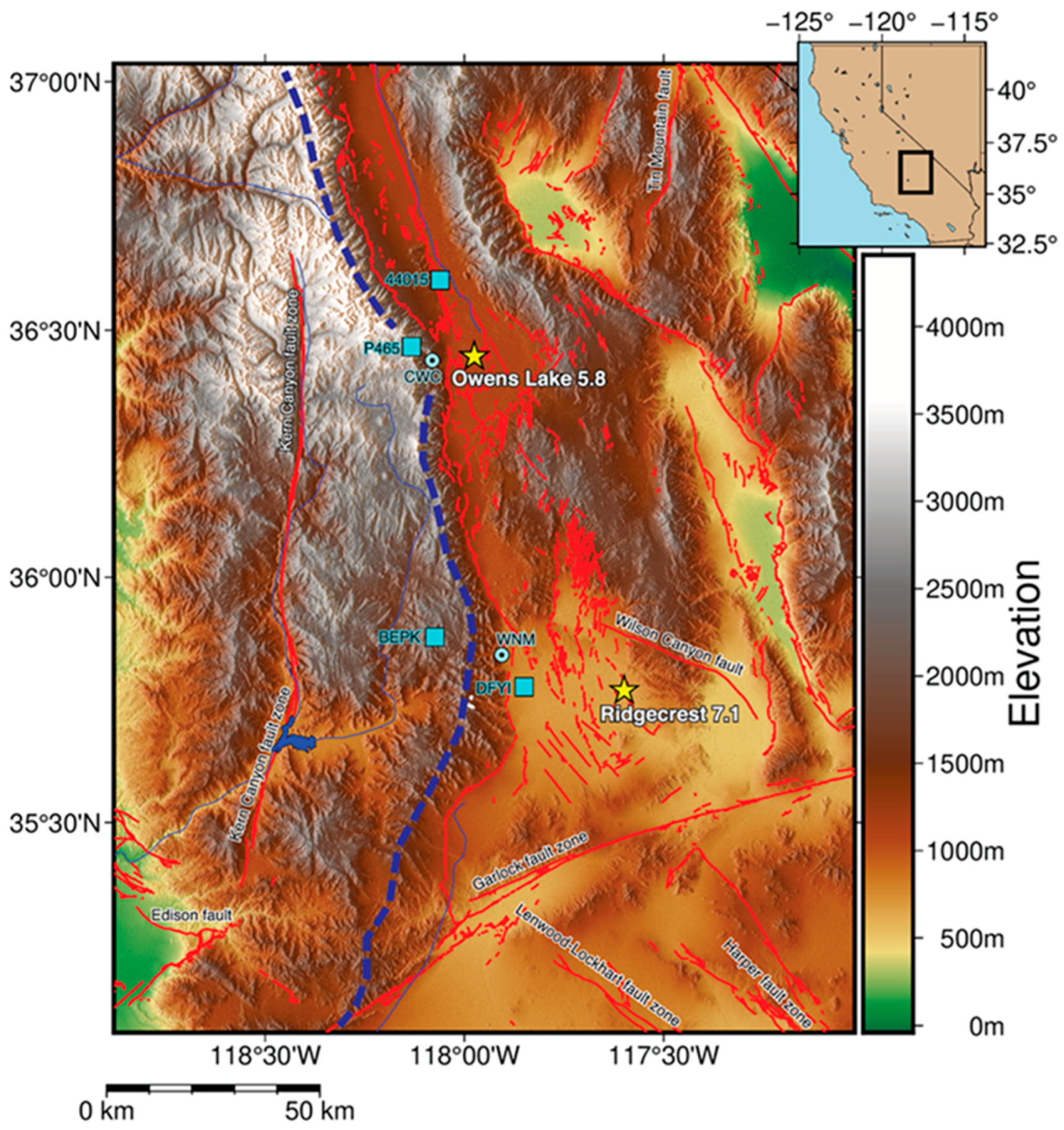


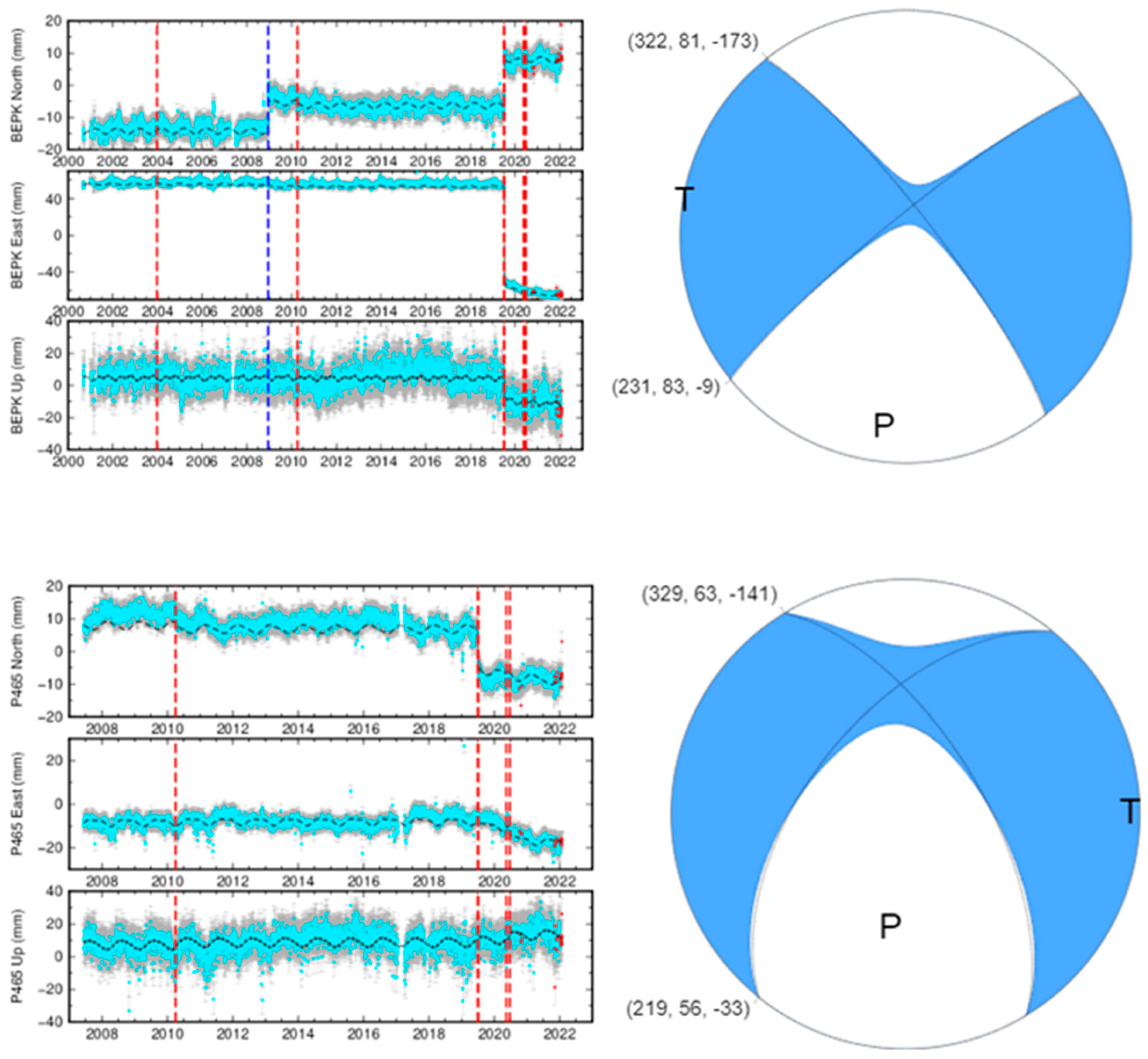
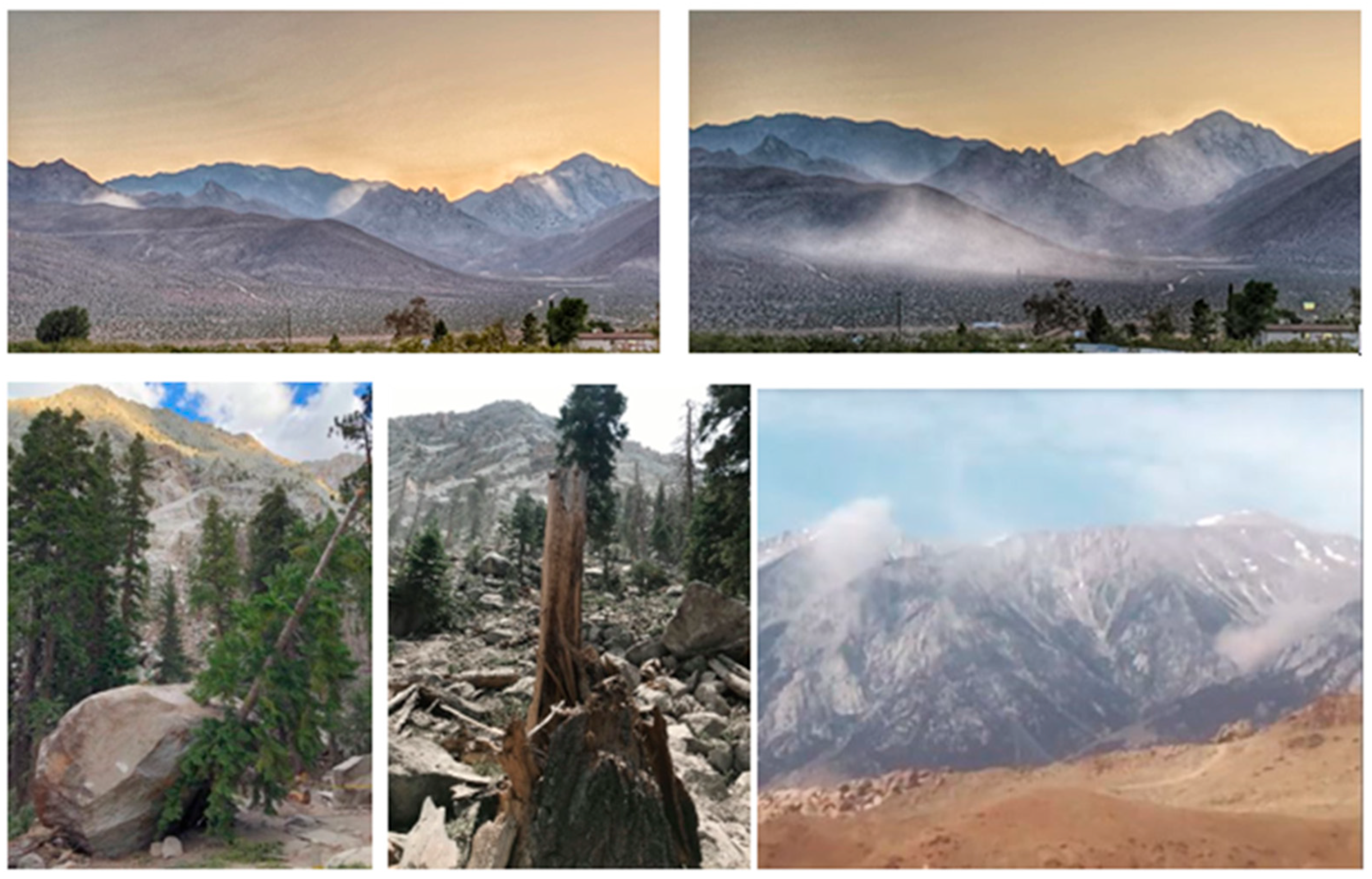
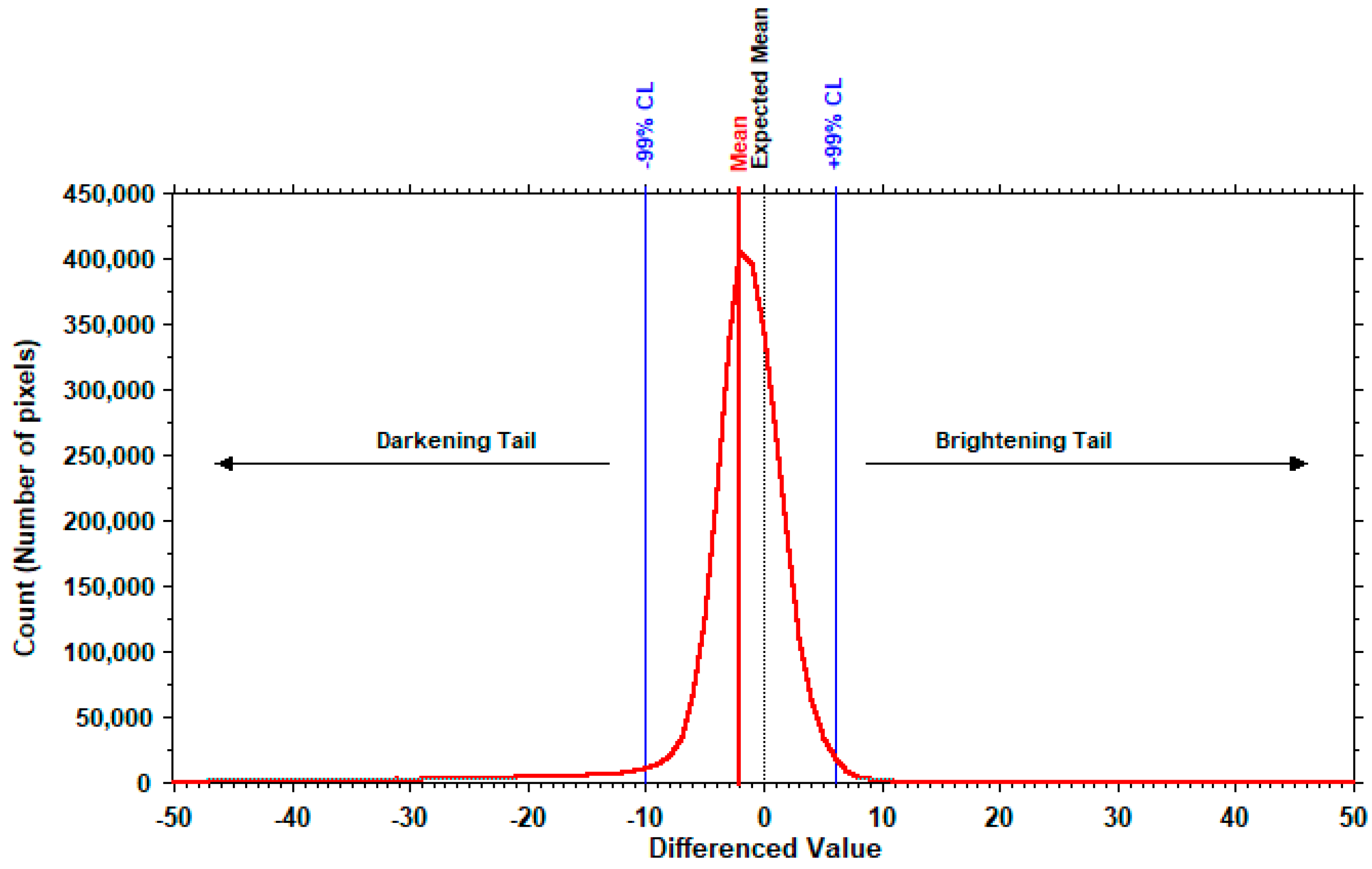
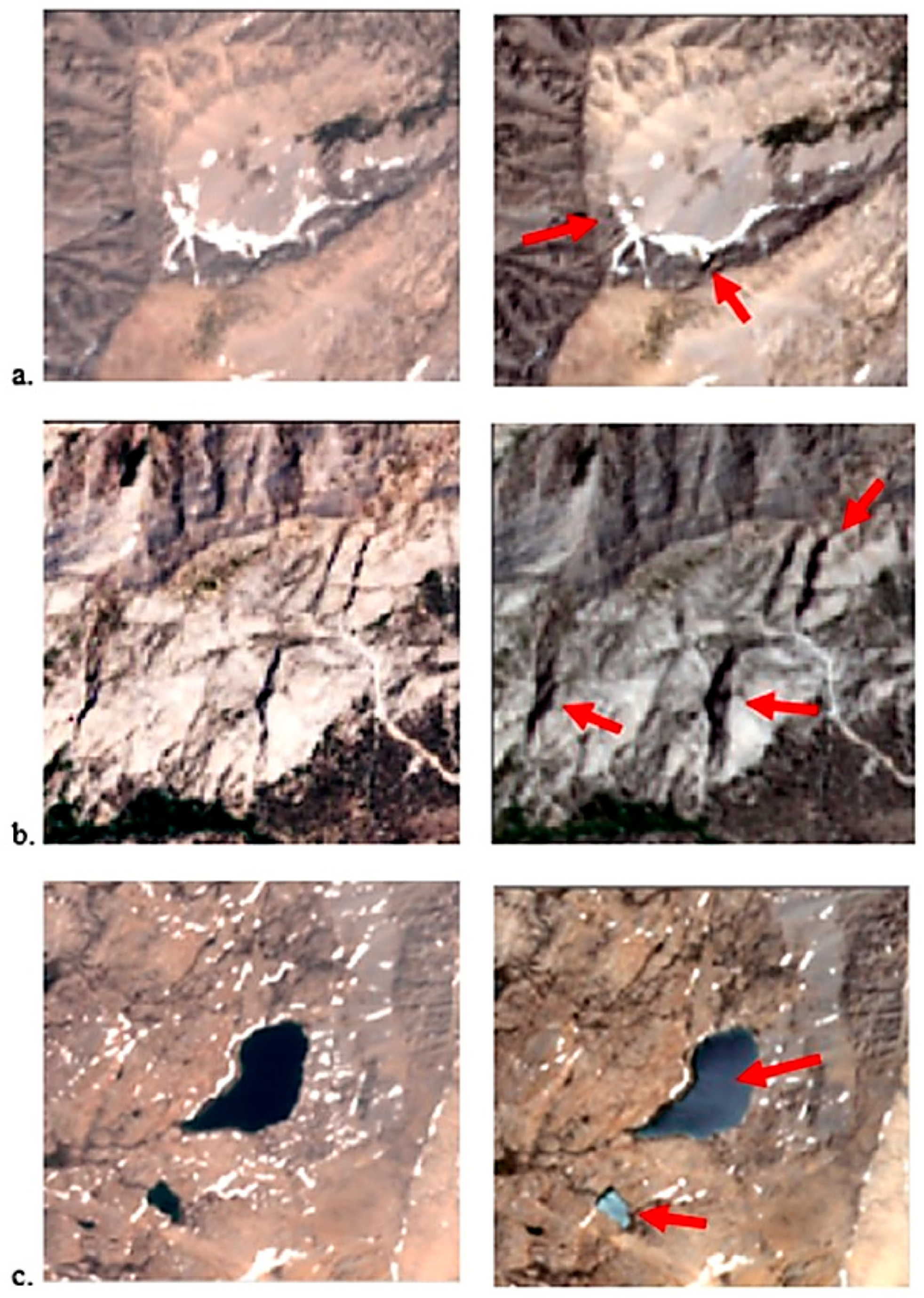
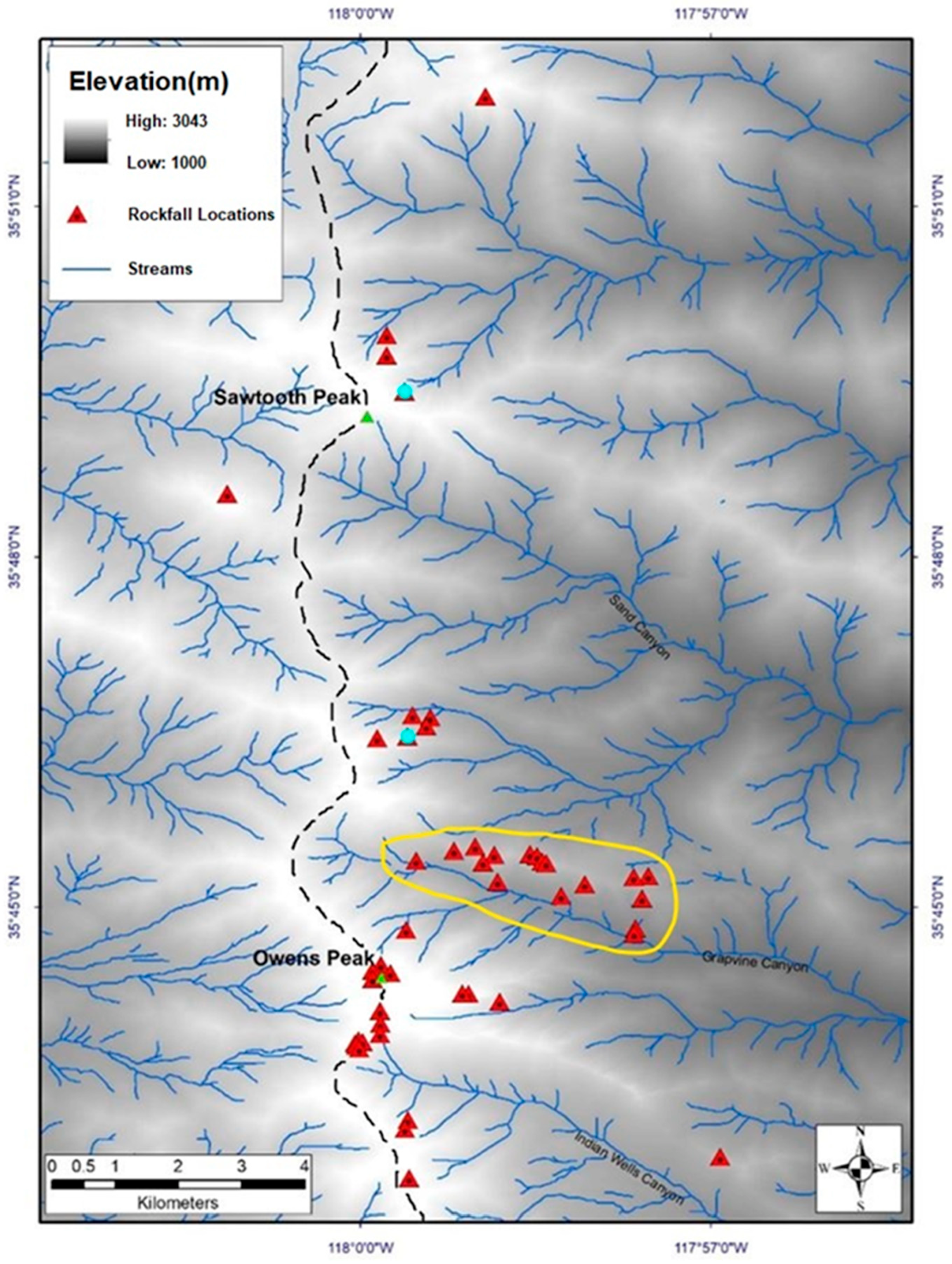
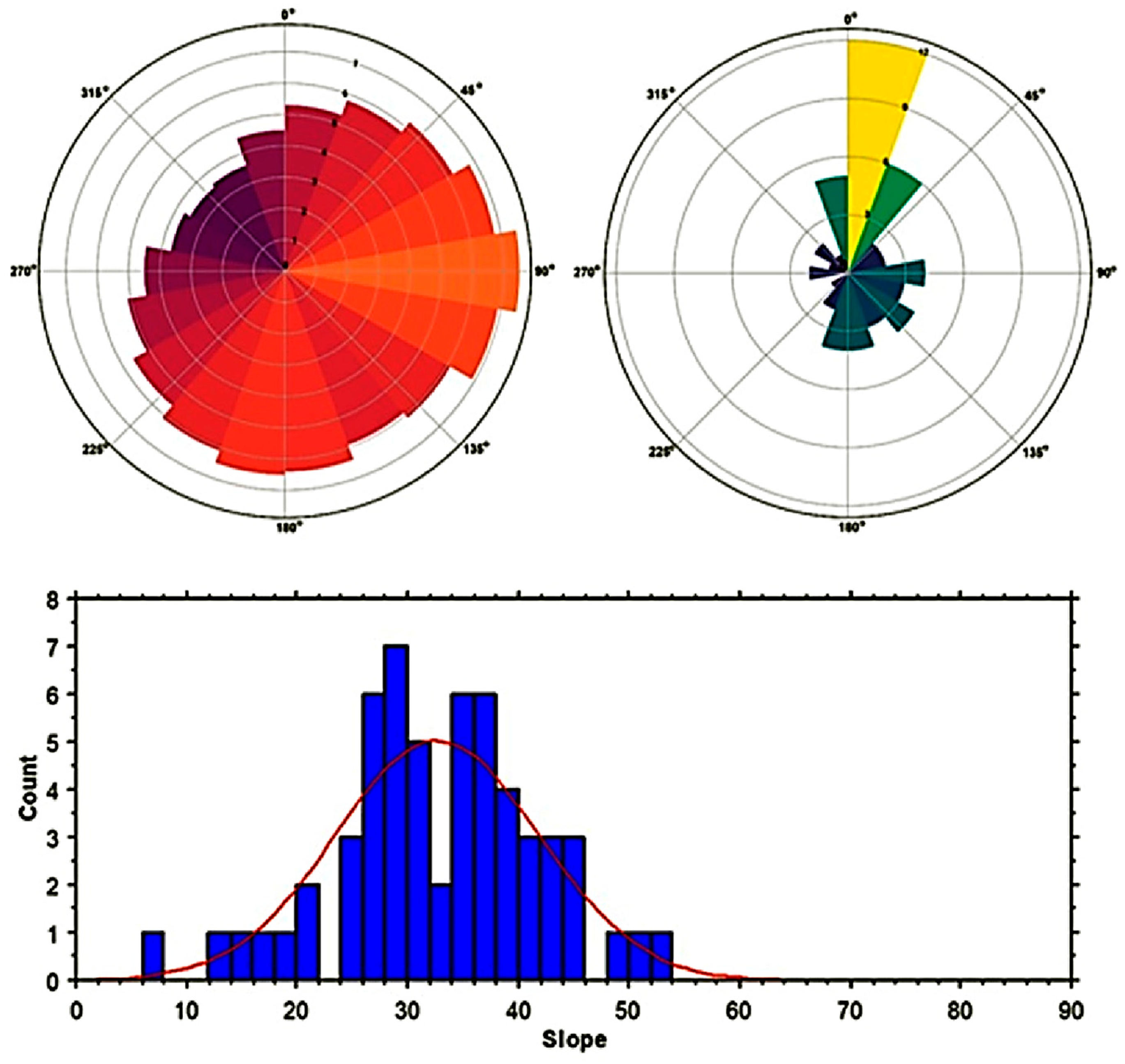
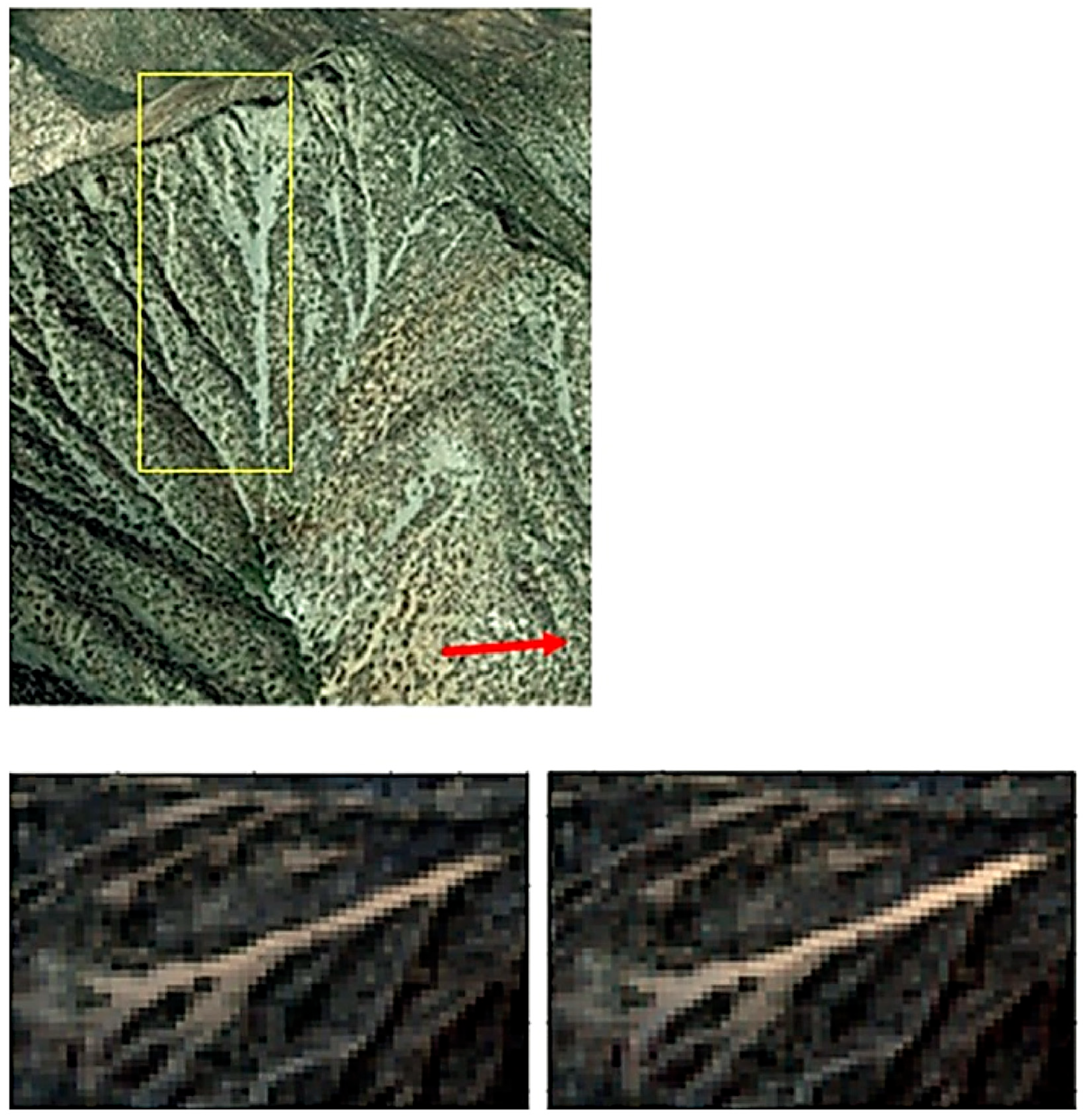

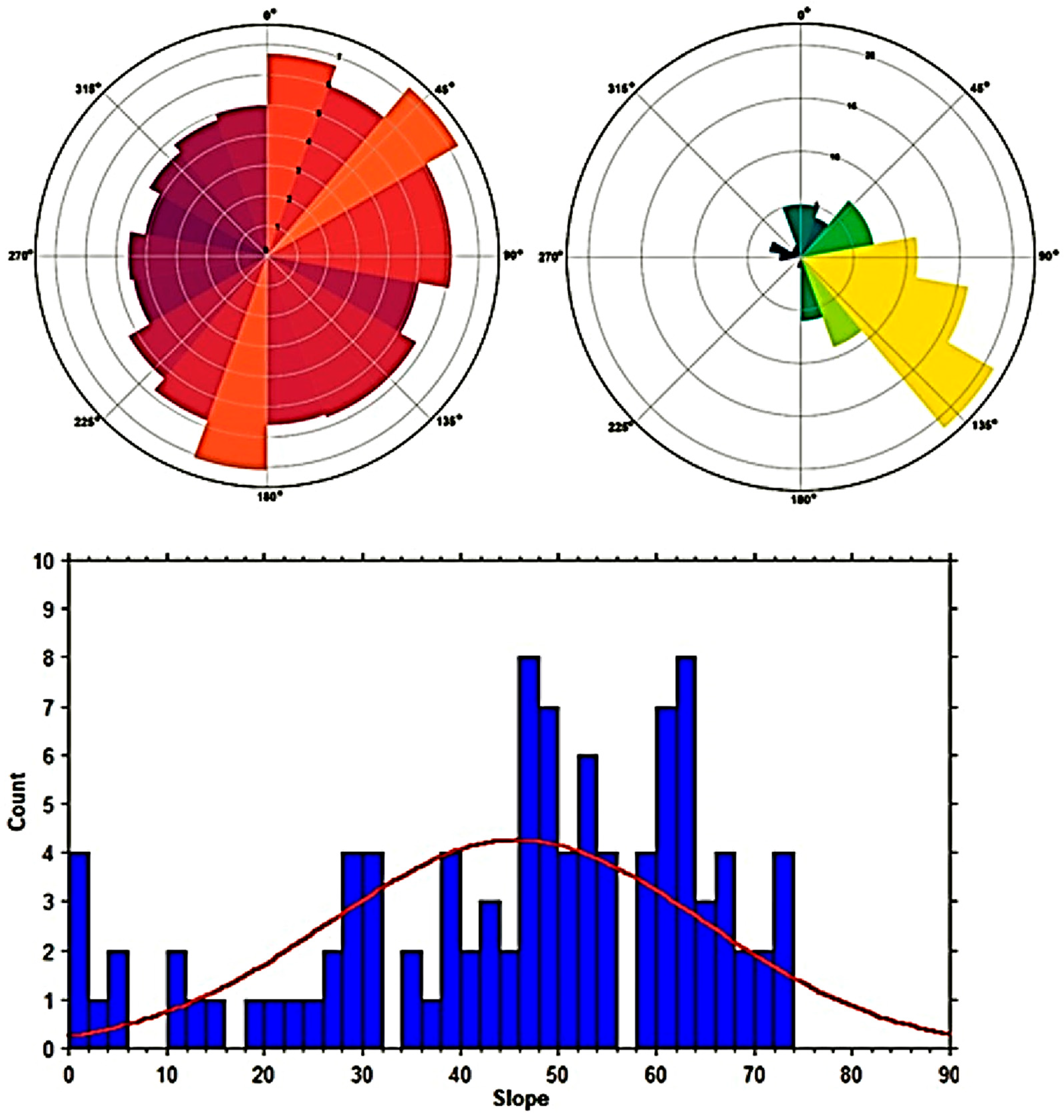
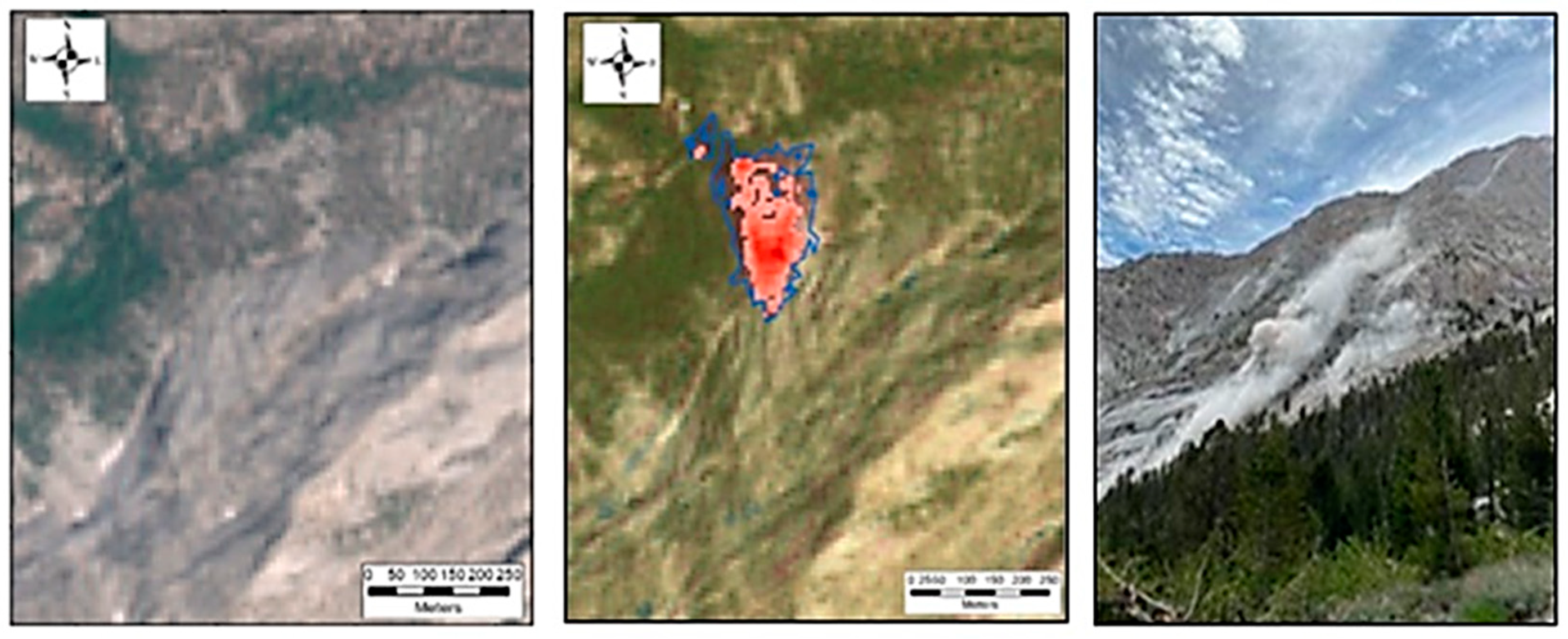

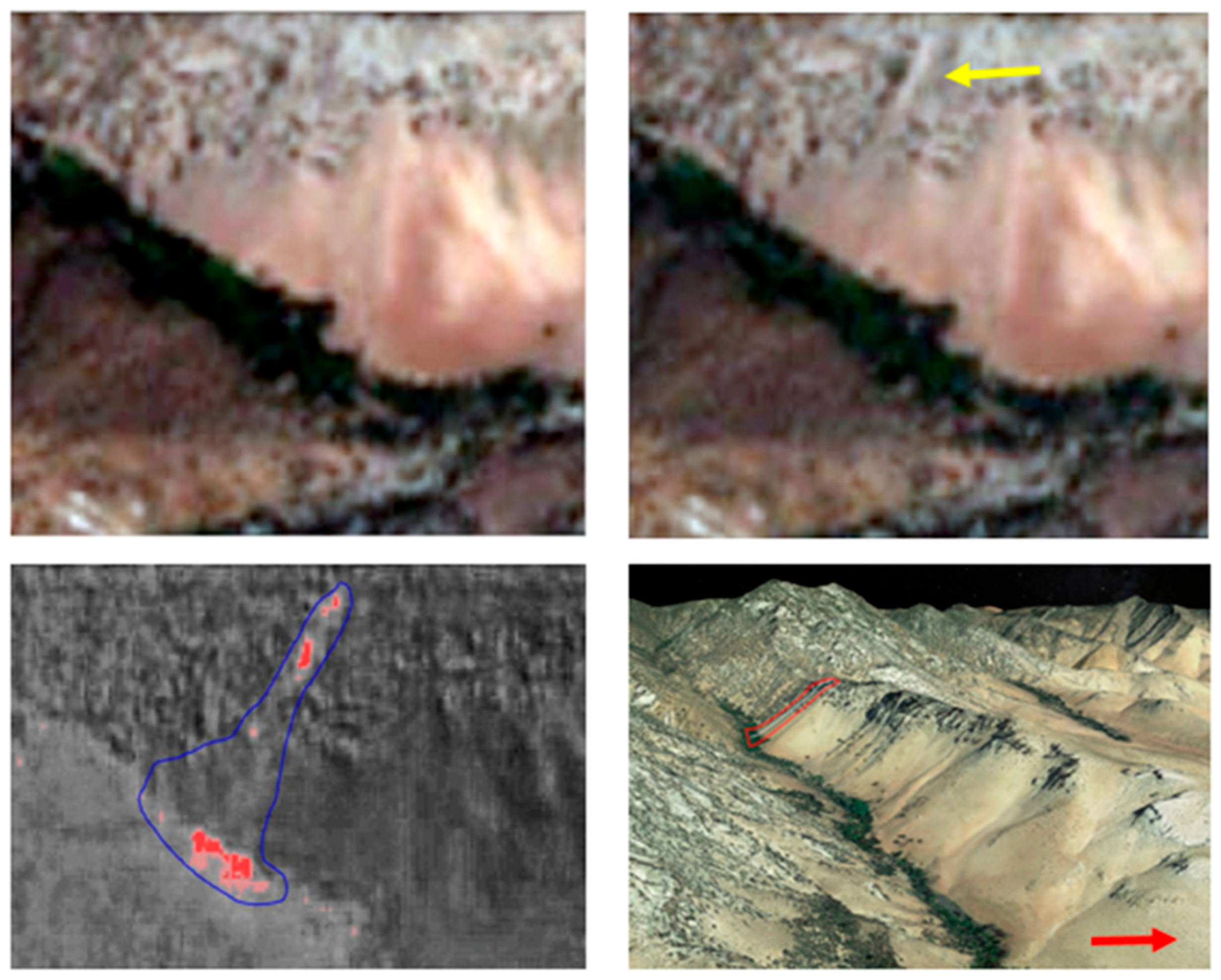
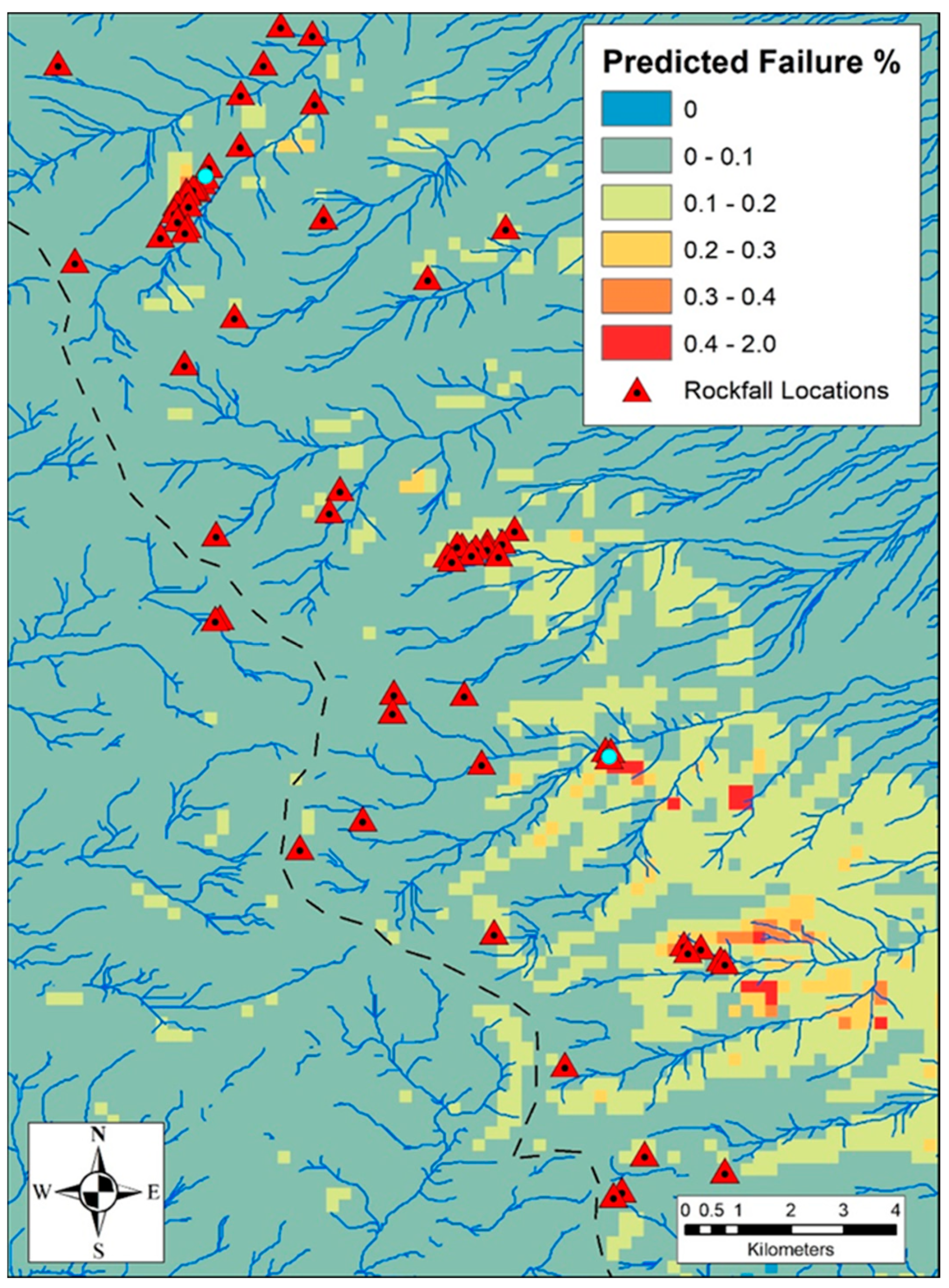
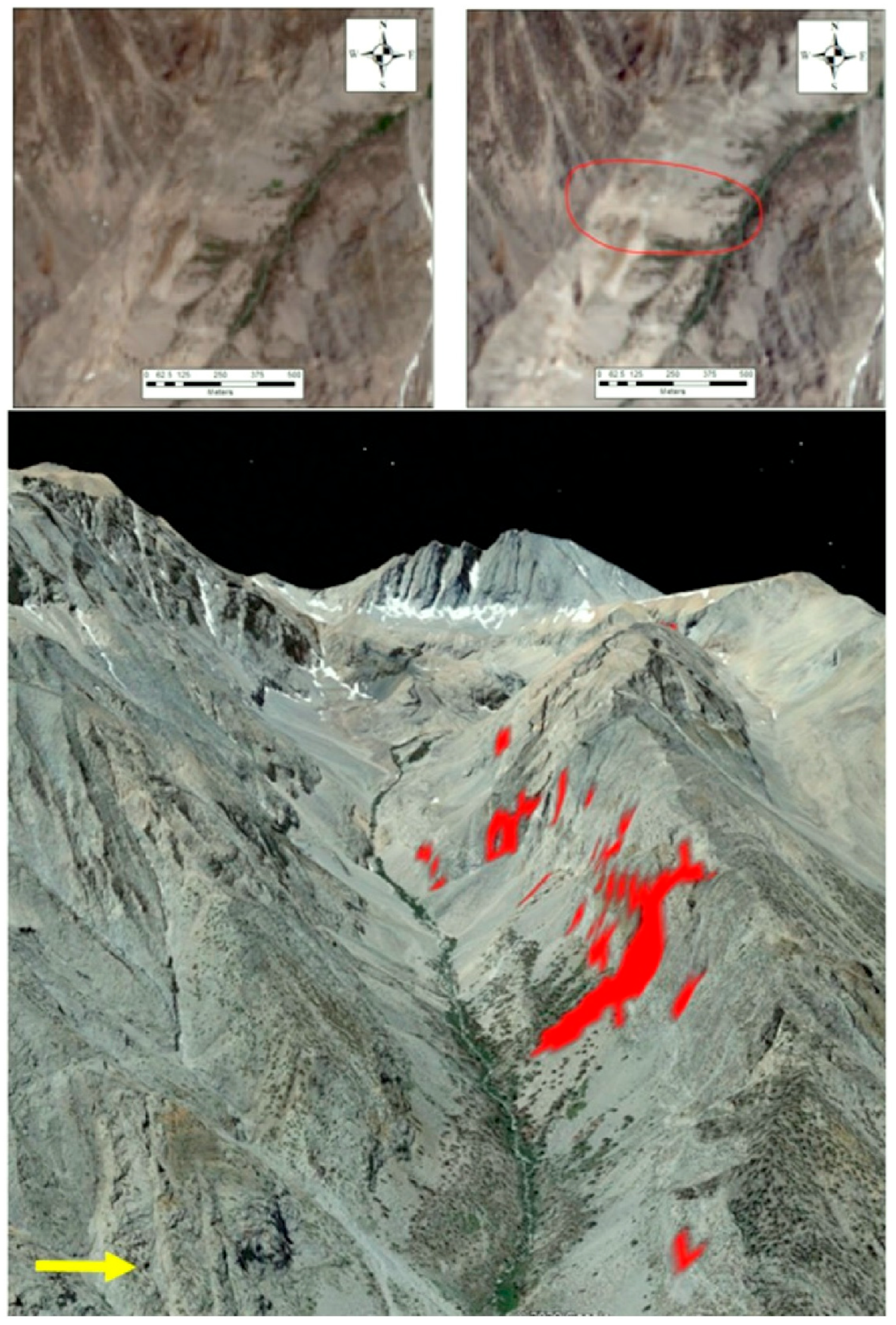

| Event Name | Date | Time (UTC-06:00) | Magnitude (MW) | Depth (km) | Latitude | Longitude |
|---|---|---|---|---|---|---|
| Ridgecrest | 5 July 2019 | 21:19:53 | 7.1 | 8.0 | 35.770°N | 117.599°W |
| Owens Lake | 24 June 2020 | 11:40:49 | 5.8 | 4.7 | 36.447°N | 117.975°W |
| Earthquake | Download Site |
|---|---|
| Waveforms for both events | California Integrated Seismic Network: Southern California Seismic Network. Caltech, USGS Pasadena, and Partners, http://www.scsn.org (accessed on 18 December 2022) doi:10.7909/C3WD3xH1 |
| Moment Tensors for both events | California Integrated Seismic Network: Southern California Seismic Network. Caltech, USGS Pasadena, and Partners, http://www.scsn.org (accessed on 18 December 2022) doi:10.7909/C3WD3xH1 |
| Ridgecrest directional offsets | USGS Hazards Program, https://earthquake.usgs.gov/monitoring/gps/LongValley/bepk (accessed on 18 December 2022) |
| Ridgecrest ShakeMap | https://earthquake.usgs.gov/earthquakes/eventpage/ci38457511/shakemap/intensity (accessed on 18 December 2022) |
| Owens Lake directional offsets | USGS Hazards Program, https://earthquake.usgs.gov/monitoring/gps/LongValley/p465 (accessed on 18 December 2022) |
| Owens Lake ShakeMap | https://earthquake.usgs.gov/earthquakes/eventpage/ci39493944/shakemap/intensity (accessed on 18 December 2022) |
Disclaimer/Publisher’s Note: The statements, opinions and data contained in all publications are solely those of the individual author(s) and contributor(s) and not of MDPI and/or the editor(s). MDPI and/or the editor(s) disclaim responsibility for any injury to people or property resulting from any ideas, methods, instructions or products referred to in the content. |
© 2023 by the authors. Licensee MDPI, Basel, Switzerland. This article is an open access article distributed under the terms and conditions of the Creative Commons Attribution (CC BY) license (https://creativecommons.org/licenses/by/4.0/).
Share and Cite
Scuderi, L.A.; Onyango, E.A.; Nagle-McNaughton, T. A Remote Sensing and GIS Analysis of Rockfall Distributions from the 5 July 2019 Ridgecrest (MW7.1) and 24 June 2020 Owens Lake (MW5.8) Earthquakes. Remote Sens. 2023, 15, 1962. https://doi.org/10.3390/rs15081962
Scuderi LA, Onyango EA, Nagle-McNaughton T. A Remote Sensing and GIS Analysis of Rockfall Distributions from the 5 July 2019 Ridgecrest (MW7.1) and 24 June 2020 Owens Lake (MW5.8) Earthquakes. Remote Sensing. 2023; 15(8):1962. https://doi.org/10.3390/rs15081962
Chicago/Turabian StyleScuderi, Louis A., Evans A. Onyango, and Timothy Nagle-McNaughton. 2023. "A Remote Sensing and GIS Analysis of Rockfall Distributions from the 5 July 2019 Ridgecrest (MW7.1) and 24 June 2020 Owens Lake (MW5.8) Earthquakes" Remote Sensing 15, no. 8: 1962. https://doi.org/10.3390/rs15081962
APA StyleScuderi, L. A., Onyango, E. A., & Nagle-McNaughton, T. (2023). A Remote Sensing and GIS Analysis of Rockfall Distributions from the 5 July 2019 Ridgecrest (MW7.1) and 24 June 2020 Owens Lake (MW5.8) Earthquakes. Remote Sensing, 15(8), 1962. https://doi.org/10.3390/rs15081962






